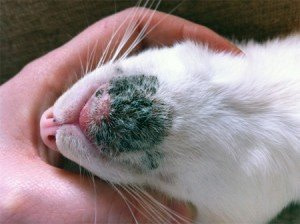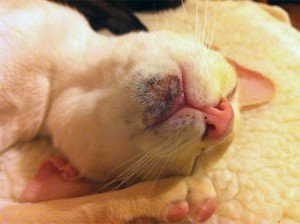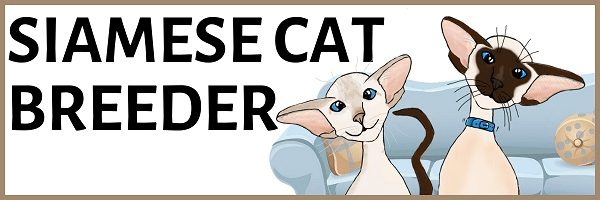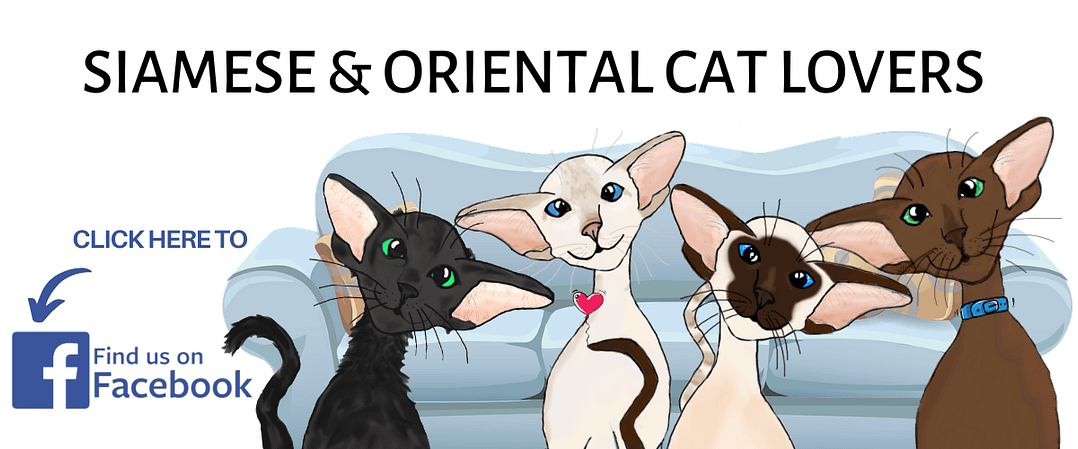What is Feline Acne?

Feline acne is one of the most common skin problems in cats, often occurring as blackheads on the chin or tail. In mild cases this may go unnoticed or owners may assume it is simply a dirty chin or flea debris. However more serious cases can require an intensive care routine and can be very painful for the cat potentially leading to infections.
Cats have glands in their dermal layer (skin) that produce sebaceous fluid. This is an oily sebum that coats the hair follicles making them waterproof as well as maintaining the suppleness of the skin. These glands can be found on the chin, lips, eyelids, and around the base of the tail. They also appear to have a role in marking territory as cats will often repeatedly rub their heads or the base of their tails against furniture, toys and even you. When these glands are overactive, the oily sebum can build up causing feline acne or stud tail.
Causes of Feline Acne
Feline acne can occur at any age, in any breed or any sex however the causes are still poorly understood. It is known as a keretinisation disorder as keratin is the protein involved in the production of hair and skin, and it relates to overproduction of sebum in the sebaceous glands on the hair follicles in the skin. However some cats are more prone to acne or more severe outbreaks of acne than others and it is clear there are several different causes of feline acne.
Hormonal
Entire male cats can be prone to acne around the base of the tail. This is because testosterone is implicated in causing the excessive production of sebum which a male uses to mark his territory. Although this is known as stud tail, females and neutered males can suffer from this as well.
Cats will often scent mark by rubbing their chin and lips against objects, especially entire females when in call. This over activity of the sebaceous glands can lead to overproduction of sebum around their chins causing feline acne. Pregnant cats can also be more prone to feline acne. Therefore there must be a hormonal cause to feline acne, however other causes should be looked at as well.
Stress
As in humans, stress can cause skin conditions or increase the severity of existing skin conditions. In cats, stress could be linked to keretinisation disorders such as feline acne.
Plastic Feeding Dishes
As plastic is porous, it can harbour bacteria that will be transferred to your cat’s chin when it drinks or feeds causing sebum build up or infection.
Allergies
Allergies to certain types of food, for instance grain, or plastic feeding bowls have been suggested as a cause of overproduction of sebum.
Hygiene
Cat acne can be associated with poor hygiene or cats that are messy eaters. If your cat is prone to a messy chin or ‘gravy chops’ after eating then a quick wipe clean can be helpful.
Symptoms of Feline Acne

The overproduction of sebum will cause the cat’s chin or tail to be coated with an oily substance that mostly looks like black ‘cruddy’ debris, dirt or blackheads. This blackhead like material is called comedones and occurs in acne cases usually around the lips and chin but can also affect the eyelids. In stud tail, this build up of sebaceous material can start around the base of the tail and sometimes spread up to the very tip. In mild cases this may go unnoticed by cat owners and may cause little discomfort to the cat.
In more severe cases, secondary infection may result leading to pus filled pustules and inflammation of the hair follicles (folliculitis). In the most severe cases, inflammation can lead to pyoderma. This is an infection of the skin characterised by inflammation of multiple hair follicles, pustules, swelling of the infected area and enlargement of the lymph nodes. At this point, the cat will obviously be in great discomfort and will need urgent veterinary care.
Treatment of Feline Acne
There are several different treatments available, most focusing on the removal of excess sebum build up and the formation of conedomes or reducing sebaceous gland over activity. If your cat does suffer from feline acne or stud tail, your vet will be able to advise you on the best course of action for your cat and monitor its treatment.
Cleaning Routine
A careful cleaning routine can help reduce the build up of excess sebum. In mild cases your vet may recommend use of a surgical scrub containing chlorhexidine such as Hibiscrub. This can be diluted and used to gently clean the affected area two to three times a day. Once the formation of conedomes has been reduced and controlled, a regular cleaning routine should be continued to prevent the acne returning, particularly if your cat is prone to regular acne breakouts. For some cats this may be a life long problem requiring daily cleaning.
When cleaning your cat’s chin or tail, please remember that they may be very sensitive and sore. It is best to try to make it an enjoyable or at least tolerable grooming activity for your cat. Start with a small area and clean very gently whilst reassuring your cat. Don’t forget that a treat at the end will help your cat remember it favourably next time.
Steroid Treatment
Oral steroids or a steroid cream can be very helpful in reducing swelling. However steroids cannot be given to pregnant or nursing females as it may pass from the mother to kittens and cause them harm. Therefore other forms of treatment must be looked for in cases of hormone related feline acne.
Ceramic Food Bowls
Switching to glass or ceramic food bowls can make a big difference in the longer term care of feline acne. These can be washed thoroughly on a regular basis using a pet safe disinfectant or in a hot dishwasher to remove all bacterial that could cause sebum build up or infection. Plastic water fountains can also be changed to the ceramic or metal water fountains that are now available.
Antibiotics
In cases of secondary infection, antibiotic treatment can be very effective, depending upon the type of bacterial infection. Infections will often require antibiotic treatment over several weeks to clear up.
Supplements
There is some evidence to show that veterinary formula supplements such as Evening Primrose Oil or Fish Oil can help feline acne however these should only be used under the direction of your vet.
Some cats will be prone to acne and have recurrent lifelong episodes, however careful attention to diet and hygiene can reduce the frequency and severity of these outbreaks. A vet should always be consulted before any course of treatment is tried and they will be able to advise on ways to prevent or reduce recurrent episodes.

